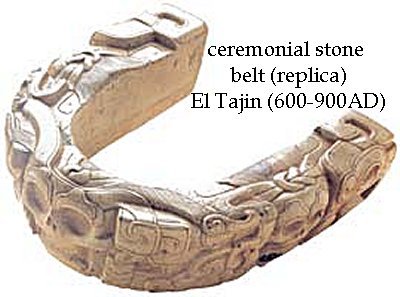Millennia Old Ceremonial Stone Belt And Maya Pok-A-Tok Ball Game
A. Sutherland - AncientPages.com - This fascinating artifact, which is displayed in the Mexican gallery of the British Museum, resembles a giant stone horseshoe.
It weighs almost 40 kilos (90 lbs; it is approximately 40 centimeters (15 inches) long and about 12 centimeters (4 inches) thick, and is made of a very beautiful green-grey speckled stone.
It is a ceremonial stone belt, as old as Pok-A-Tok, a ball game that ancient Maya most probably inherited from the Olmecs. Pok-A-Tok was played since at least 1,400 BC by the pre-Columbian peoples of ancient Mesoamerica. Known among the Aztecs as “tlachtli”, Pok-A-Tok was an important part of their political and religious festivals.
Its purpose has long remained a puzzle. It was not a typical yoke for draught animals or carthorses (as it was initially thought) because there were no such horses or other draught animals in Central America until the Spaniards brought them from Europe in the sixteenth century.
According to Michael Whittington, an expert on these ancient ball games, these heavy, yoke-like stone belts were probably worn as part of the ritual ceremonies at the beginning of the game and for a very brief time. Worn during the games, they would significantly slow down a player’s competition capabilities such as maneuverability.
Ceremonial stone belts are representations of represent the padded belts made of leather, padded cloth or other textiles and worn by players to protect their hips. Other protection made of jaguar skin or deer) was for the head, knees, hips and elbows.
When the Spaniards arrived they were amazed by the ball that the game was played with, because it was made of rubber, a substance unknown to Europeans.
The very first view of a bouncing ball, a round object seemingly defying gravity and shooting around in random directions, must have been extremely perplexing.
“They call the material of this ball hule [rubber] … jumping and bouncing are its qualities, upward and downward, to and fro. It can exhaust the pursuer running after it before he can catch up with it…” wrote the Spanish after he observed the game.
Pre-Columbian ball courts have been found in the center of almost every Maya city, throughout Mesoamerica, as for example at Copán, as far south as modern Nicaragua, and possibly as far north as what is now the U.S. state of Arizona.
In some modern form and with slightly varying rules, the ball game tradition has survived through time until today in many places throughout Mesoamerica. One rule, however, has remained unchanged: the game was played on an I-shaped court, with rings set 20 to 30 feet off the ground.
One of the Ball Courts of the Mayan ruins in Coba, Mexico. Image credit: Wikipedia
Ball games were spectacular and dangerous in ancient Central America. In Pok-A-Tok, captives were forced to play the game for their lives. It was not easy to stay alive in this game. The aim was to keep the ball in the air and finally to land it in the opponents’ end of the court.
The losers became sacrificial victims and faced torture and execution immediately following the competition.
Even if played as a sport and for fun, there was always a team of losers and at least, their captain was traditionally sacrificed to the gods.
To the game, it used an 8- inch (or more) ball of solid baked rubber (at least eight times a soccer ball). It was heavy and it could weigh from 3 or 4 kilos (8 lbs) to almost 15 kilos (30 lbs).
The number of players ("Pitzhil") varied between 2 and 5 in each team.
The players had only one desire: to get the ball through a narrow, stone ring placed on the court wall, often as high up as 20 feet from the ground (or onto a marker).
They used only shoulders, heads, elbows, wrists, and hips but never – hands.
Symbolic Meaning
For the Maya, the ball represented the Sun, the Moon, or planets and the court was the cosmos.
Pok-A-Tok was considered the sacred game of the gods played on Earth and was not just a competitive sport.
It held a special place in the belief system of the ancient Central Americans and symbolized a mythical struggle of life, death, war, and sacrifice. The ball game was a ceremony dedicated to the memory of the ancestors and linked to agriculture and calendar cycles.
The ball courts were considered entrances to the underworld. The biggest ball court of all in Mesoamerica - 545 feet long and 225 feet wide – is located among the ruins of Chichén Itzá in Mexico's Yucatán peninsula.
For the Aztec, for example, the game symbolized reenactment of the daily trial of the Sun rising after being born again from nighttime of fighting the underworld.
Written by – A. Sutherland AncientPages.com Staff Writer
Copyright © AncientPages.com All rights reserved. This material may not be published, broadcast, rewritten or redistributed in whole or part without the express written permission of AncientPages.com
Expand for referencesReferences:
Scarborough Vernon L. The Mesoamerican Ballgame
Gillings T. Last Game For The Gods
More From Ancient Pages
-
 First Detailed Academic Study Of East African Maritime Traditions Shows Changes In Boatbuilding
Archaeology | May 11, 2022
First Detailed Academic Study Of East African Maritime Traditions Shows Changes In Boatbuilding
Archaeology | May 11, 2022 -
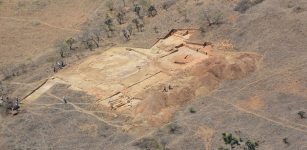 Gigantic Ancient Palace Unearthed In Mexico’s Valley Of Oaxaca
Archaeology | Mar 29, 2017
Gigantic Ancient Palace Unearthed In Mexico’s Valley Of Oaxaca
Archaeology | Mar 29, 2017 -
 Startling Evidence Modern Humans Lived In The Mandrin Cave 56,800 Years Ago Where They Met The Neanderthals
Archaeology | Mar 12, 2022
Startling Evidence Modern Humans Lived In The Mandrin Cave 56,800 Years Ago Where They Met The Neanderthals
Archaeology | Mar 12, 2022 -
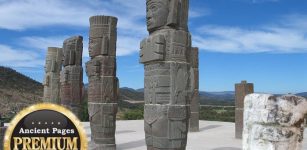 Secret Ancient Knowledge Of The Toltecs Examined
Civilizations | Aug 16, 2019
Secret Ancient Knowledge Of The Toltecs Examined
Civilizations | Aug 16, 2019 -
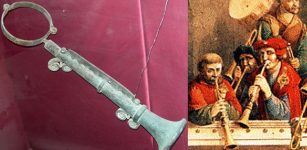 What Was The Medieval Shame Flute?
Ancient History Facts | Jan 27, 2020
What Was The Medieval Shame Flute?
Ancient History Facts | Jan 27, 2020 -
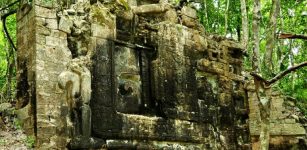 Lost Ancient Mayan Cities Lagunita And Tamchen Hidden In The Jungle Reveal Their Secrets
Featured Stories | Jun 25, 2017
Lost Ancient Mayan Cities Lagunita And Tamchen Hidden In The Jungle Reveal Their Secrets
Featured Stories | Jun 25, 2017 -
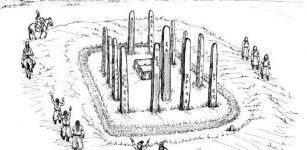 Discovery Of Ancient Sarcophagus And 14 Stone Pillars Covered With Inscriptions In Eastern Mongolia
Archaeology | Dec 22, 2017
Discovery Of Ancient Sarcophagus And 14 Stone Pillars Covered With Inscriptions In Eastern Mongolia
Archaeology | Dec 22, 2017 -
 Reconstructed Roman Gateway Tells The Story Of Britain’s Invasion
Featured Stories | Aug 26, 2023
Reconstructed Roman Gateway Tells The Story Of Britain’s Invasion
Featured Stories | Aug 26, 2023 -
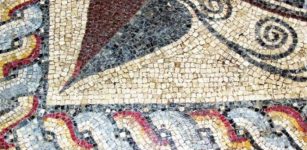 1,800-Year-Old Villa Of Famous Ancient Fisherman Phainos Unearthed In Turkey
Archaeology | Jun 20, 2018
1,800-Year-Old Villa Of Famous Ancient Fisherman Phainos Unearthed In Turkey
Archaeology | Jun 20, 2018 -
 The Curse Of Chief Chocorua Who Died On The Mountain That Bears His Name
Featured Stories | Mar 9, 2019
The Curse Of Chief Chocorua Who Died On The Mountain That Bears His Name
Featured Stories | Mar 9, 2019 -
 Chromium Steel Was First Produced In Ancient Persia
Ancient Technology | Sep 24, 2020
Chromium Steel Was First Produced In Ancient Persia
Ancient Technology | Sep 24, 2020 -
 Nurikabe: Trickster That Manifests Itself As Invisible, Impassable Wall In Japanese Old Beliefs
Featured Stories | Oct 21, 2019
Nurikabe: Trickster That Manifests Itself As Invisible, Impassable Wall In Japanese Old Beliefs
Featured Stories | Oct 21, 2019 -
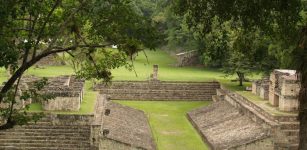 On This Day In History: First European Sights The Ruins Of Ancient Maya City Of Copán – On Mar 8, 1576
News | Mar 8, 2017
On This Day In History: First European Sights The Ruins Of Ancient Maya City Of Copán – On Mar 8, 1576
News | Mar 8, 2017 -
 America’s First Civilization Was Made Up Of ‘Sophisticated’ Engineers – New Evidence
Archaeology | Sep 2, 2021
America’s First Civilization Was Made Up Of ‘Sophisticated’ Engineers – New Evidence
Archaeology | Sep 2, 2021 -
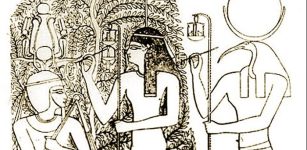 Heliopolis ‘Sun City’ Was One Of The Most Ancient Cities Of Egypt
Featured Stories | Oct 6, 2021
Heliopolis ‘Sun City’ Was One Of The Most Ancient Cities Of Egypt
Featured Stories | Oct 6, 2021 -
 Mysterious Ancient Human ‘Ghost’ Species Discovered With Help Of Saliva
Archaeology | Jul 25, 2017
Mysterious Ancient Human ‘Ghost’ Species Discovered With Help Of Saliva
Archaeology | Jul 25, 2017 -
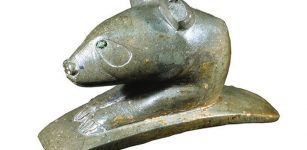 Use Of Tobacco Pipes By Hopewell People Tells A New Story
Archaeology | Jun 28, 2021
Use Of Tobacco Pipes By Hopewell People Tells A New Story
Archaeology | Jun 28, 2021 -
 Ancient DNA Yields Surprising Findings On World’s Earliest Seafarers
Archaeology | Jun 30, 2022
Ancient DNA Yields Surprising Findings On World’s Earliest Seafarers
Archaeology | Jun 30, 2022 -
 Ancient Secrets Of Sacred Lismore – Is There A ‘Second’ Iona In Scotland?
Archaeology | Jul 4, 2017
Ancient Secrets Of Sacred Lismore – Is There A ‘Second’ Iona In Scotland?
Archaeology | Jul 4, 2017 -
 DNA Study Shows Pre-Historic Wallacea Was A Melting Pot Of Human Genetic Ancestries
Archaeology | Jun 9, 2022
DNA Study Shows Pre-Historic Wallacea Was A Melting Pot Of Human Genetic Ancestries
Archaeology | Jun 9, 2022


